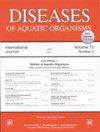Metabolomics captures the differential metabolites in the replication pathway of snakehead vesiculovirus regulated by glutamine.
IF 1.1
4区 农林科学
Q3 FISHERIES
引用次数: 0
Abstract
Snakehead vesiculovirus (SHVV) is a negative-sense single-stranded RNA virus that infects snakehead fish. This virus leads to illness and mortality, causing significant economic losses in the snakehead aquaculture industry. The replication and spread of SHVV in cells, which requires glutamine as a nitrogen source, is accompanied by alterations in intracellular metabolites. However, the metabolic mechanisms underlying the inhibition of viral replication by glutamine deficiency are poorly understood. This study utilized liquid chromatography-mass spectrometry to measure the differential metabolites between the channel catfish Parasilurus asotus ovary cell line infected with SHVV under glutamine-containing and glutamine-deprived conditions. Results showed that the absence of glutamine regulated 4 distinct metabolic pathways and influenced 9 differential metabolites. The differential metabolites PS(16:0/16:0), 5,10-methylene-THF, and PS(18:0/18:1(9Z)) were involved in amino acid metabolism. In the nuclear metabolism functional pathway, differential metabolites of guanosine were observed. In the carbohydrate metabolism pathway, differential metabolites of UDP-d-galacturonate were detected. In the signal transduction pathway, differential metabolites of SM(d18:1/20:0), SM(d18:1/22:1(13Z)), SM(d18:1/24:1(15 Z)), and sphinganine were found. Among them, PS(18:0/18:1(9Z)), PS(16:0/16:0), and UDP-d-galacturonate were involved in the synthesis of phosphatidylserine and glycoprotein. The compound 5,10-methylene-THF provided raw materials for virus replication, and guanosine and sphingosine are related to virus virulence. The differential metabolites may collectively participate in the replication, packaging, and proliferation of SHVV under glutamine deficiency. This study provides new insights and potential metabolic targets for combating SHVV infection in aquaculture through metabolomics approaches.代谢组学捕捉到受谷氨酰胺调控的蛇头膀胱病毒复制途径中的不同代谢物。
乌鳢囊状病毒(SHVV)是一种感染乌鳢的负义单链 RNA 病毒。这种病毒会导致疾病和死亡,给乌鳢养殖业造成重大经济损失。SHVV 需要谷氨酰胺作为氮源,它在细胞中的复制和传播伴随着细胞内代谢物的改变。然而,人们对谷氨酰胺缺乏抑制病毒复制的代谢机制知之甚少。本研究利用液相色谱-质谱法测量了在含谷氨酰胺和谷氨酰胺缺乏条件下感染了SHVV的沟鲇副鲇卵巢细胞系的不同代谢物。结果表明,谷氨酰胺的缺失调节了4种不同的代谢途径,影响了9种不同的代谢物。差异代谢物PS(16:0/16:0)、5,10-亚甲基-THF和PS(18:0/18:1(9Z))参与了氨基酸代谢。在核代谢功能途径中,观察到鸟苷的不同代谢物。在碳水化合物代谢途径中,检测到不同的 UDP-d-半乳糖醛酸代谢物。在信号转导途径中,发现了 SM(d18:1/20:0)、SM(d18:1/22:1(13Z))、SM(d18:1/24:1(15 Z))和鞘氨醇的不同代谢产物。其中,PS(18:0/18:1(9Z))、PS(16:0/16:0)和 UDP-d-半乳糖醛酸参与了磷脂酰丝氨酸和糖蛋白的合成。化合物 5,10-亚甲基-THF 为病毒复制提供了原料,鸟苷和鞘磷脂与病毒的毒力有关。在谷氨酰胺缺乏的情况下,这些不同的代谢物可能共同参与了SHVV的复制、包装和增殖。这项研究为通过代谢组学方法抗击水产养殖中的 SHVV 感染提供了新的见解和潜在的代谢靶标。
本文章由计算机程序翻译,如有差异,请以英文原文为准。
求助全文
约1分钟内获得全文
求助全文
来源期刊

Diseases of aquatic organisms
农林科学-兽医学
CiteScore
3.10
自引率
0.00%
发文量
53
审稿时长
8-16 weeks
期刊介绍:
DAO publishes Research Articles, Reviews, and Notes, as well as Comments/Reply Comments (for details see DAO 48:161), Theme Sections and Opinion Pieces. For details consult the Guidelines for Authors. Papers may cover all forms of life - animals, plants and microorganisms - in marine, limnetic and brackish habitats. DAO''s scope includes any research focusing on diseases in aquatic organisms, specifically:
-Diseases caused by coexisting organisms, e.g. viruses, bacteria, fungi, protistans, metazoans; characterization of pathogens
-Diseases caused by abiotic factors (critical intensities of environmental properties, including pollution)-
Diseases due to internal circumstances (innate, idiopathic, genetic)-
Diseases due to proliferative disorders (neoplasms)-
Disease diagnosis, treatment and prevention-
Molecular aspects of diseases-
Nutritional disorders-
Stress and physical injuries-
Epidemiology/epizootiology-
Parasitology-
Toxicology-
Diseases of aquatic organisms affecting human health and well-being (with the focus on the aquatic organism)-
Diseases as indicators of humanity''s detrimental impact on nature-
Genomics, proteomics and metabolomics of disease-
Immunology and disease prevention-
Animal welfare-
Zoonosis
 求助内容:
求助内容: 应助结果提醒方式:
应助结果提醒方式:


